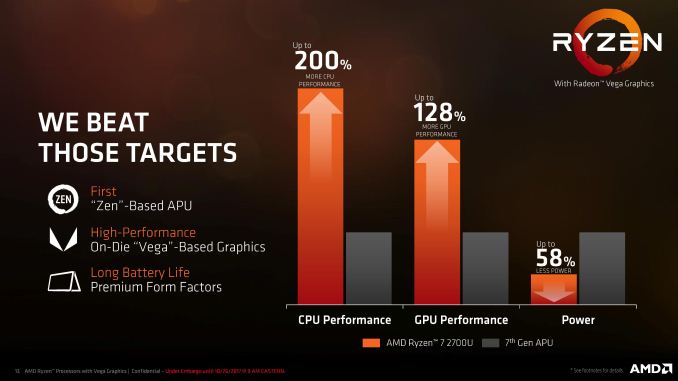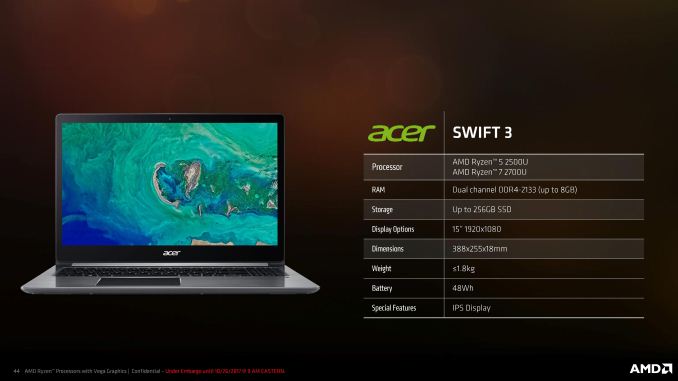Ryzen Mobile is Launched: AMD APUs for Laptops, with Vega and Updated Zen
by Ian Cutress on October 26, 2017 9:00 AM ESTAMD Ryzen Mobile: Zen 1.5
During our pre-briefings on Ryzen Mobile, it was asked why the two new APUs were using the 2000-series numbers, and not the 1000-series numbers like the desktop parts. It was assumed by the press that the first generation of Ryzen would all be under the 1000-series, including the mobile parts. The response given by Kevin Lensing, AMD’s Corporate VP of the Client Business Unit, was that so many of the design ideas that AMD wanted to put into the original desktop Ryzen (but couldn’t due to time) eventually ended up in Ryzen Mobile, such as the updated precision boost. While there are no architectural changes to Zen to warrant a next-generation microarchitecture name, this version of Ryzen’s periphery (i.e. the power) was more in-line with an original vision and had to be presented as such. This is why we have Ryzen 7 2700U, rather than a Ryzen 7 1700U. He would not comment if the true next generation Ryzen desktop naming would still be the 2000 series, or if we would go straight to 3000. Who knows, it might alternate.
The state of Zen aside, AMD’s return to high-performance computing with the Zen core was naturally going to trickle down into the notebook space. The question everyone asked is if such a high-power, high-performance core was going to make it in such a small power envelope: especially when you add some big graphics core next to it. In our desktop Ryzen reviews, we saw per-core power go as low as 8W per core, and AMD’s Vega was power hungry – promising to put four cores and some graphics into a single piece of silicon with a 15W TDP sounded harder than an uphill task, almost Sisyphean in nature. AMD has approached that by taking new methods to its power topology, how it manages that power, and found a combination of frequencies and performance that tally up to that 15W mark. They have also worked closely with the first three OEMs that are launching systems today to ensure a good user experience.
For performance, Ryzen Mobile has four cores with multithreading, with frequencies up to 3.8 GHz. This should give the mobile processor enough grunt under the hood in the 15W envelope to cater for a significant number of demanding workloads. GPU performance is also up, with AMD also hoping to push the hardware into a number of gaming-focused devices with FreeSync panels in the new few months. AMD is also touting significant power reductions during high-load tasks, leading to a 270% performance per watt improvement. More impressive is the steps taken towards how the processor manages power between cores and the GPU: a very complex implementation hopefully leading to a better power profile and 15-30% better battery life than previous generations for common use cases.
For the launch, AMD has partnered with HP, Acer and Lenovo for systems to go on shelves. As I am currently writing this, only HP provided any information about their upcoming systems and we’re likely to scramble when the other press releases come out. None of the three designs are ultimate eye-catching flagships, but rather approaching that middle-range $600-$1000 notebook territory with 13.3 inch 4K displays, up to 1TB SSDs, 48-55Wh batteries, and a device or two that can flip into a tablet. When we played briefly with the Acer unit in our pre-briefing, there was no lag – a user would be hard-pressed to immediately see a difference to a comparative Intel system.
Ultimately AMD has several very hard tasks ahead of it for Ryzen Mobile. Firstly it has to re-educate the sales teams at brick and mortar stores like Best Buy, who have only ever seen AMD has the low-cost budget option. If they still think the same way when Ryzen Mobile comes to town, they won’t be recommending them.
Second, they have to educate the public – after years of miserable user experiences leading to negative feedback loops, AMD has to convince these users that it is worth looking at AMD-powered devices again and there isn’t some sort of catch. Part of this solution will be in how well AMD integrates itself into the OEM sampling strategy for reviews, and if any reviewers are going to get devices this time around.
Third, AMD is several steps behind Intel in its marketing message: while Intel is trying to explain new ways to use the hardware (such as the failed ‘PC Does Whaaat?’ campaign almost a couple of years ago to the day), AMD is on the ‘I’m here too, and I’m just as good’ message. Back when we analyzed the Carrizo user experience, one thing we pointed out is that with most Intel flagships, most users do not even know what processor is inside – to these customers, saying ‘I’m just as good’ might give the impression ‘well what was wrong before?’. It might take AMD a round of flagships and XPS 13 or Zenbook Infinity-type designs to get the attention on their side of the discussion.
We have reached out to all three of the main OEMs who have Ryzen Mobile systems being announced today, but only one responded in time. This doesn’t bode well for any sampling, but we’re sitting here with a megaphone until we get one. Stay Tuned.
As part of this launch, AMD also discussed its progress towards its 25x20 goal, and AMD actually provided some data on how they are calculating this. We analyzed what AMD still has to do in a separate article, and you can read about it here:
http://www.anandtech.com/show/11965/amds-progress-on-its-25x20-goal-the-task-ahead














140 Comments
View All Comments
Rickyxds - Saturday, October 28, 2017 - link
i5 better than i7LordanSS - Saturday, October 28, 2017 - link
If a 15W part does this well... I'd say a 35-45W APU (which can be undervolted if necessary) with 4C/8T and ECC would make for a pretty awesome ZFS NAS....Lolimaster - Saturday, October 28, 2017 - link
The absurd efficiency of zen cores at low frequency really helps squeezing extra frequency from the gpu.From 700-800Mhz on avrg for mobile to 1.3Ghz is brutal.
deksman2 - Tuesday, November 7, 2017 - link
That's because of the manuf, process AMD uses.The GLOFO 14nm currently used for Ryzen and Vega is more suited for lower clocks not high ones.
It's one of the reasons why Vega has a higher power draw than Pascal in desktop space... its currently clocked too high and has too much unnecessary voltage (and we noted that undervolting Vega 56 can bring down power consumption to 1070 levels, while simultaneously overclocking it on the core and HBM would bring up performance to 1080 level but at a lower power draw than 1080.
At lower frequencies though, I would imagine that power draw would go down substantially for both Ryzen and Vega... plus, Ryzen is only using one CCX here, so that likely helps as well.
Will be really good if AMD decides to make a Raven Ridge 2 for example by making 8c/16th APU with Vega iGP's... all connected via Infinity Fabric of course on 7nm and same power draw.
I would imagine it would be doable, but at the same time, clocks would increase by a fairly good amount... the desktop could run on 5 GhZ base using upcoming 7nm manuf. process from IBM... as for Raven Ridge 2... possibly 3.2 GhZ base with 8 cores and 2 Navi iGP
hanselltc - Sunday, October 29, 2017 - link
Now all I need is a HP Envy 13 or a Razer Blade Stealth with this inside.Ro_Ja - Monday, October 30, 2017 - link
I'm looking forward to replacing my ASUS X550ZE-XX026H. Dual graphics is annoying. Can't even disable onboard GPU to use R5 M230.tyaty1 - Monday, October 30, 2017 - link
Thy look good, but if they can not support 16/32gb RAM, it is deal breaker.I have a Asus G551JW with 4200H, which performs very good, but I ant upgrade for quad core, which does not throttle, and it graphics performance is not much worse than the 960m.
tipoo - Monday, October 30, 2017 - link
Swift 3 will be interesting, wonder how this will compare to the MX150.neblogai - Monday, October 30, 2017 - link
I'd expect ~80% performance in 3DMark, and ~50% in games. Not just because of less bandwidth- but also because it runs with total 25W TDP for both CPU and GPU- while X150 system will run on approximately 40W (15W + 25W).